Effect of the Combination of Superabsorbent Polymers for Autogenous Shrinkage Control with Steel Fibers of High-Performance Concrete under Uniaxial Tension Using DIC
Abstract
1. Introduction
2. Materials and Methods
2.1. Materials
2.1.1. Steel Fibers
2.1.2. Superabsorbent Polymers (SAP)
2.1.3. Mix Proportions
2.2. Experimental Program
2.2.1. Measurement of Flowability and Compressive Strength
2.2.2. Autogenous Shrinkage
2.2.3. Uni-Axial Testing Equipment with Digital Image Correlation (DIC) Arrangement
3. Results and Discussions
3.1. Influence on Mortar Flow
3.2. Compressive Strength
3.3. Autogenous Shrinkage
3.4. Tensile Properties
Analytical Tensile Evaluation of SAP Incorporation
4. Conclusions
- HSC can incorporate a dosage of 0.6% of SAP, keeping high strength and workability.
- Autogenous shrinkage can be adequately mitigated with the content of 0.3% of SAP. However, a content of 0.2% may give sufficient reduction to avoid cracking.
- The content of 0.3% of SAP was shown to be beneficial in different aspects. It successfully mitigated autogenous shrinkage, can be used without major influence on workability, is compatible with high compressive strength, and significantly enhanced the SFRC’s ductile performance.
- The variable engagement model used was capable of describing the behavior of the SFRC with SAP. Moreover, it can be used in future finite element applications.
Author Contributions
Funding
Acknowledgments
Conflicts of Interest
References
- Jensen, O.M.; Hansen, P.F. Water-entrained cement-based materials:I. Principles and theoretical background. Cem. Concr. Res. 2001, 31, 647–654. [Google Scholar] [CrossRef]
- Jensen, O.M.; Hansen, P.F. Water-entrained cement-based materials: II. Experimental observations. Cem. Concr. Res. 2002, 32, 973–978. [Google Scholar] [CrossRef]
- Schröfl, C.; Mechtcherine, V.; Gorges, M. Relation between the molecular structure and the efficiency of superabsorbent polymers (SAP) as concrete admixture to mitigate autogenous shrinkage. Cem. Concr. Res. 2012, 42, 865–873. [Google Scholar] [CrossRef]
- Hasholt, M.T.; Jensen, O.M.; Kovler, K.; Zhutovsky, S. Can superabsorent polymers mitigate autogenous shrinkage of internally cured concrete without compromising the strength? Constr. Build. Mater. 2012, 31, 226–230. [Google Scholar] [CrossRef]
- Mechtcherine, V.; Reinhardt, H. Application of Super Absorbent Polymers (SAP) in Concrete Construction: State-of-the-Art Report Prepared by Technical Committee 225-SAP, 1st ed.; Mechtcherine, V., Reinhardt, H., Eds.; Springer: Dordrecht, The Netherlands, 2012; ISBN 978-94-007-2733-5. [Google Scholar]
- Mechtcherine, V.; Gorges, M.; Schroefl, C.; Assmann, A.; Brameshuber, W.; Ribeiro, A.B.; Cusson, D.; Custódio, J.; Da Silva, E.F.; Ichimiya, K.; et al. Effect of internal curing by using superabsorbent polymers (SAP) on autogenous shrinkage and other properties of a high-performance fine-grained concrete: Results of a RILEM round-robin test. Mater. Struct. Constr. 2014, 47, 541–562. [Google Scholar] [CrossRef]
- Shen, D.; Wang, X.; Cheng, D.; Zhang, J.; Jiang, G. Effect of internal curing with super absorbent polymers on autogenous shrinkage of concrete at early age. Constr. Build. Mater. 2016, 106, 512–522. [Google Scholar] [CrossRef]
- Wyrzykowski, M.; Igarashi, S.I.; Lura, P.; Mechtcherine, V. Recommendation of RILEM TC 260-RSC: Using superabsorbent polymers (SAP) to mitigate autogenous shrinkage. Mater. Struct. Constr. 2018, 51, 1–7. [Google Scholar] [CrossRef]
- Reis, P.F.O.; Evangelista, F.; Silva, E.F. Profile of internal relative humidity and depth of drying in cementitious materials containing superabsorbent polymer and nano-silica particles. Constr. Build. Mater. 2020, 237, 117412. [Google Scholar] [CrossRef]
- Naaman, A.E.; Reinhardt, H.W. Proposed classification of HPFRC composites based on their tensile response. Mater. Struct. Constr. 2006, 39, 547–555. [Google Scholar] [CrossRef]
- Kwon, S.; Nishiwaki, T.; Mihashi, H. Self-healing Capability of Ultra-High-Performance Fiber-Reinforced Concrete (UHP-FRC). In Proceedings of the Fifth International Conference on Self-Healing Materials, Durham, NC, USA, 22–24 June 2015. [Google Scholar]
- Van Zijl, G.P.A.G.; Wittmann, F.H.; Oh, B.H.; Kabele, P.; Toledo Filho, R.D.; Fairbairn, E.M.R.; Slowik, V.; Ogawa, A.; Hoshiro, H.; Mechtcherine, V.; et al. Durability of strain-hardening cement-based composites (SHCC). Mater. Struct. Constr. 2012, 45, 1447–1463. [Google Scholar] [CrossRef]
- Afroughsabet, V.; Biolzi, L.; Ozbakkaloglu, T. High-Performance Fiber-Reinforced Concrete: A Review. J. Mater. Sci. 2016, 51, 6517–6551. [Google Scholar] [CrossRef]
- Naaman, A.E. Fiber reinforced concrete: Five decades of progress. In Proceedings of the 4th Brazilian Conference on Composite Materials, io de Janeiro, Brazil, 22–25 July 2018; pp. 35–56. [Google Scholar]
- Di Prisco, M.; Plizzari, G.; Vandewalle, L. Fibre reinforced concrete: New design perspectives. Mater. Struct. Constr. 2009, 42, 1261–1281. [Google Scholar] [CrossRef]
- Yao, Y.; Zhu, Y.; Yang, Y. Incorporation superabsorbent polymer (SAP) particles as controlling pre-existing flaws to improve the performance of engineered cementitious composites (ECC). Constr. Build. Mater. 2012, 28, 139–145. [Google Scholar] [CrossRef]
- Snoeck, D.; Van Tittelboom, K.; Steuperaert, S.; Dubruel, P.; De Belie, N. Self-healing cementitious materials by the combination of microfibres and superabsorbent polymers. J. Intell. Mater. Syst. Struct. 2014, 25, 13–24. [Google Scholar] [CrossRef]
- Tosun-Felekoğlu, K.; Felekoğlu, B.; Ranade, R.; Lee, B.Y.; Li, V.C. The role of flaw size and fiber distribution on tensile ductility of PVA-ECC. Compos. Part B Eng. 2014, 56, 536–545. [Google Scholar] [CrossRef]
- Snoeck, D.; De Belie, N. Effect of fibre type and superabsorbent polymers on the self-healing properties of strain-hardening cementitious materials. In Proceedings of the 11th International Symposium on Brittle Matrix Composites (BMC), Warsaw, Poland, 28–30 September 2015; pp. 213–222. [Google Scholar]
- Sherir, M.A.A.; Hossain, K.M.A.; Lachemi, M. Interaction of Superabsorbent Polymers and Admixtures on the Properties of Engineered Cementitious Composites. Can. Soc. Civ. Eng. 2015, 1, 191–200. [Google Scholar]
- Snoeck, D. Self-Healing and Microstructure of Cementitious Materials with Microfibres and Superabsorbent Polymers. Ph.D. Thesis, Ghent University, Ghent, Belgium, 15 December 2015. [Google Scholar]
- Mignon, A.; Snoeck, D.; Dubruel, P.; Van Vlierberghe, S.; De Belie, N. Crack Mitigation in Concrete: Superabsorbent Polymers as Key to Success? Materials 2017, 10, 237. [Google Scholar] [CrossRef]
- Li, V.C. On Engineered Cementitious Composites (ECC) A Review of the Material and Its Applications. J. Adv. Concr. Technol. 2003, 1, 215–230. [Google Scholar] [CrossRef]
- Wang, S.; Li, V.C. Tailoring of pre-existing flaws in ECC matrix for saturated strain hardening. Fract. Mech. Concr. Struct. 2004, 8, 1005–1012. [Google Scholar]
- Li, V.C.; Wang, S.; Wu, C. Tensile strain-hardening behavior of polyvinyl alcohol engineered cementitious composite (PVA-ECC). ACI Mater. J. Am. Concr. Inst. 2001, 98, 483–492. [Google Scholar]
- Liu, J.; Farzadnia, N.; Shi, C. Effects of superabsorbent polymer on interfacial transition zone and mechanical properties of ultra-high performance concrete. Constr. Build. Mater. 2020, 231, 117142. [Google Scholar] [CrossRef]
- Wang, X.; Zhang, S.; Wang, C.; Cao, K.; Wei, P.; Wang, J. Effect of steel fibers on the compressive and splitting-tensile behaviors of cellular concrete with millimeter-size pores. Constr. Build. Mater. 2019, 221, 60–73. [Google Scholar] [CrossRef]
- ABNT NBR 16697. Cimento Portland—Requisitos; Brazilian Association of Technical Standards: São Paulo, Brazil, 2018; p. 9. [Google Scholar]
- ABNT NBR 13956. Sílica Ativa Para uso com Cimento Portland em Concreto, Argamassa e Pasta Parte 1: Requisitos; Brazilian Association of Technical Standards: São Paulo, Brazil, 2012; p. 6. [Google Scholar]
- ABNT NBR 7211. Agregados Para Concreto—Especificação; Brazilian Association of Technical Standards: São Paulo, Brazil, 2009; p. 9. [Google Scholar]
- Jensen, O.M. Water absorption of superabsorbent polymers in a cementitious environment. In International RILEM Conference On Advances in Construction Materials Through Science and Engineering; RILEM Publications SARL: Hong Kong, China, 2011; pp. 22–35. [Google Scholar]
- Snoeck, D.; Velasco, L.F.; Mignon, A.; Van Vlierberghe, S.; Dubruel, P.; Lodewyckx, P.; De Belie, N. The effects of superabsorbent polymers on the microstructure of cementitious materials studied by means of sorption experiments. Cem. Concr. Res. 2015, 77, 26–35. [Google Scholar] [CrossRef]
- De Rooij, M.; Van Tittelboom, K.; De Belie, N.; Schlangen, E. RILEM TC 221-SHC: Self-Healing Phenomena in Cement-Based Materials; Springer Science & Business Media: Berlim, Germany, 2013; Volume 1. [Google Scholar]
- DIN 18555-2 Testing of Mortars Containing Mineral Binders—Freshly Mixed Mortars Containing Aggregates of Dense Structure (Heavy Aggregates)—Determination of Consistence, Bulk Density and Air Content; DIN/EN: Berlin, Germany, 1982.
- ABNT NBR 5739. Concrete—Compression Test of Cylindrical Specimens; Brazilian Association of Technical Standards: São Paulo, Brazil, 2018; p. 71. [Google Scholar]
- Silva, E.F. Variações Dimensionais em Concretos de alto Desempenho Contendo Aditivo Redutor de Retração. Ph.D. Thesis, Universidade do Rio de Janeiro, Rio de Janeiro, Brazil, 2007. [Google Scholar]
- Tawaza, E. Autogenous Shrinkage of Concrete, 1st ed.; CRC Press: London, UK, 1999. [Google Scholar]
- ASTM C490 Standard Practice for Use of Apparatus for the Determination of Length Change of Hardened Cement Paste, Mortar, and Concrete; ASTM Standard: West Conshohocken, PA, USA, 2000.
- Yokota, H.; Rokugo, K.; Sakata, N. JSCE Recommendations for Design and Construction of High Performance Fiber Reinforced Cement Composite with Multiple Fine Cracks. In High Performance Fiber Reinforced Cement Composites; Springer: Tokyo, Japan, 2008. [Google Scholar]
- Schreier, H.; Orteu, J.J.; Sutton, M.A. Image Correlation for Shape, Motion and Deformation Measurements: Basic Concepts, Theory and Applications; Springer: Berlin, Germany, 2009. [Google Scholar]
- BS EN 12390-6. Testing Hardened Concrete. Tensile Splitting Strength of Test Specimens; British Standard Institution: London, UK, 2009; p. 14. [Google Scholar]
- Paiva, H.; Esteves, L.; Cachim, P.; Ferreira, V.F. Rheology and hardened properties of single-coat render mortars with different types of water retaining agents. Constr. Build. Mater. 2009, 1141–1146. [Google Scholar] [CrossRef]
- Bayasi, M.Z.; Soroushian, P. Effect of steel fiber reinforcement on fresh mix properties of concrete. ACI Mater. J. 1992, 89, 369–374. [Google Scholar]
- Ferrara, L.; Meda, A. Relationships between fibre distribution, workability and the mechanical properties of SFRC applied to precast roof elements. Mater. Struct. Constr. 2006, 39, 411–420. [Google Scholar] [CrossRef]
- Holschemacher, K.; Mueller, T.; Ribakov, Y. Effect of steel fibres on mechanical properties of high-strength concrete. Mater. Des. 2010, 31, 2604–2615. [Google Scholar] [CrossRef]
- Filho, R.D.T.; Silva, E.F.; Lopes, A.N.M.; Mechtcherine, V.; Dudziak, L. Effect of superabsorbent polymers on the workability of concrete and mortar. In Application of Super Absorbent Polymers (SAP) in Concrete Construction: State-of-the-Art Report Prepared by Technical Committee 225-SAP; Springer: Berlin, Germany, 2012; pp. 39–50. [Google Scholar]
- Liu, J.; Khayat, K.H.; Shi, C. Effect of superabsorbent polymer characteristics on rheology of ultra-high performance concrete. Cem. Concr. Compos. 2020, 112, 103636. [Google Scholar] [CrossRef]
- Faping, L.; Jiesheng, L. Study on the Properties and Mechanism of Mortars Modified by Super Absorbent Polymers. J. Test. Eval. 2019, 47, 20170374. [Google Scholar] [CrossRef]
- Dudziak, L.; Mechtcherine, V. Mitigation of volume changes of ultra-high performance concrete (UHPC) by using super absorbent polymers. In Proceedings of the 2nd International Symposium on Ultra High Performance Concrete, Kassel, Germany, 5–7 March 2008; pp. 425–432. [Google Scholar]
- Zhao, S.; Jensen, O.M.; Hasholt, M.T. Measuring absorption of superabsorbent polymers in cementitious environments. Mater. Struct. Constr. 2020, 53, 1–16. [Google Scholar] [CrossRef]
- Snoeck, D.; Schaubroeck, D.; Dubruel, P.; De Belie, N. Effect of high amounts of superabsorbent polymers and additional water on the workability, microstructure and strength of mortars with a water-to-cement ratio of 0.50. Constr. Build. Mater. 2014, 72, 148–157. [Google Scholar] [CrossRef]
- Chindasiriphan, P.; Yokota, H.; Pimpakan, P. Effect of fly ash and superabsorbent polymer on concrete self-healing ability. Constr. Build. Mater. 2020, 233, 116975. [Google Scholar] [CrossRef]
- Lee, H.X.D.; Wong, H.S.; Buenfeld, N.R. Self-sealing of cracks in concrete using superabsorbent polymers. Cem. Concr. Res. 2016, 79, 194–208. [Google Scholar] [CrossRef]
- ACI Committee 363. 363R-10 Report on High-Strength Concrete; ACI Mater. J.: Farmington Hills, MI, USA, 2010. [Google Scholar]
- Concreto Para Fins Estruturais-Classificação pela Massa Específica, por Grupos de Resistência e Consistência; Assoc. Bras. Normas Técnicas: São Paulo, Brazil, 2015; ABNT NBR 8953:2015.
- Lura, P.; Jensen, O.M.; Van Breugel, K. Autogenous shrinkage in high-performance cement paste: An evaluation of basic mechanisms. Cem. Concr. Res. 2003, 33, 223–232. [Google Scholar] [CrossRef]
- Wyrzykowski, M.; Terrasi, G.; Lura, P. Expansive high-performance concrete for chemical-prestress applications. Cem. Concr. Res. 2018, 107, 275–283. [Google Scholar] [CrossRef]
- Aveston, J.; Kelly, A. Theory of multiple fracture of fibrous composites. J. Mater. Sci. 1973, 8, 352–362. [Google Scholar] [CrossRef]
- Gray, R.J. Analysis of the effect of embedded fibre length on fibre debonding and pull-out from an elastic matrix—Part 1 Review of theories. J. Mater. Sci. 1984, 19, 861–870. [Google Scholar] [CrossRef]
- Rossi, P.; Richer, S. Numerical modelling of concrete cracking based on a stochastic approach. Mater. Struct. 1987, 20, 334–337. [Google Scholar] [CrossRef]
- Rasheed, M.A.; Prakash, S.S. Behavior of hybrid-synthetic fiber reinforced cellular lightweight concrete under uniaxial tension—Experimental and analytical studies. Constr. Build. Mater. 2018, 162, 857–870. [Google Scholar] [CrossRef]
- Voo, J.Y.L.; Foster, S. Tensile-fracture of fibre-reinforced concrete: Variable engagement mode. In 6th International RILEM Symposium on Fibre Reinforced Concretes; RILEM Publications SARL: Varenna, Italy, 2004; pp. 875–884. [Google Scholar]
- Lei, Y.; Dura, V.; Sdn, T.; Foster, S.; Sydney, U.; Voo, Y.L. Variable Engagement Model for the Design of Fibre Reinforced Concrete Structures. In Proceedings of the Advanced Materials for Construction of Bridges, Buildings, and Other Structures III, Davos, Switzerland, 7–12 September 2005. [Google Scholar]
- Orange, G.; Acker, P.; Vernet, C. A new generation of UHP Concrete: Ductal damage resistance and micromechanical analysis. In Proceedings of the Fifth RILEM Symp. Fiber-Reinforced Concr., Lyon, France, 13–15 September 2000. [Google Scholar]
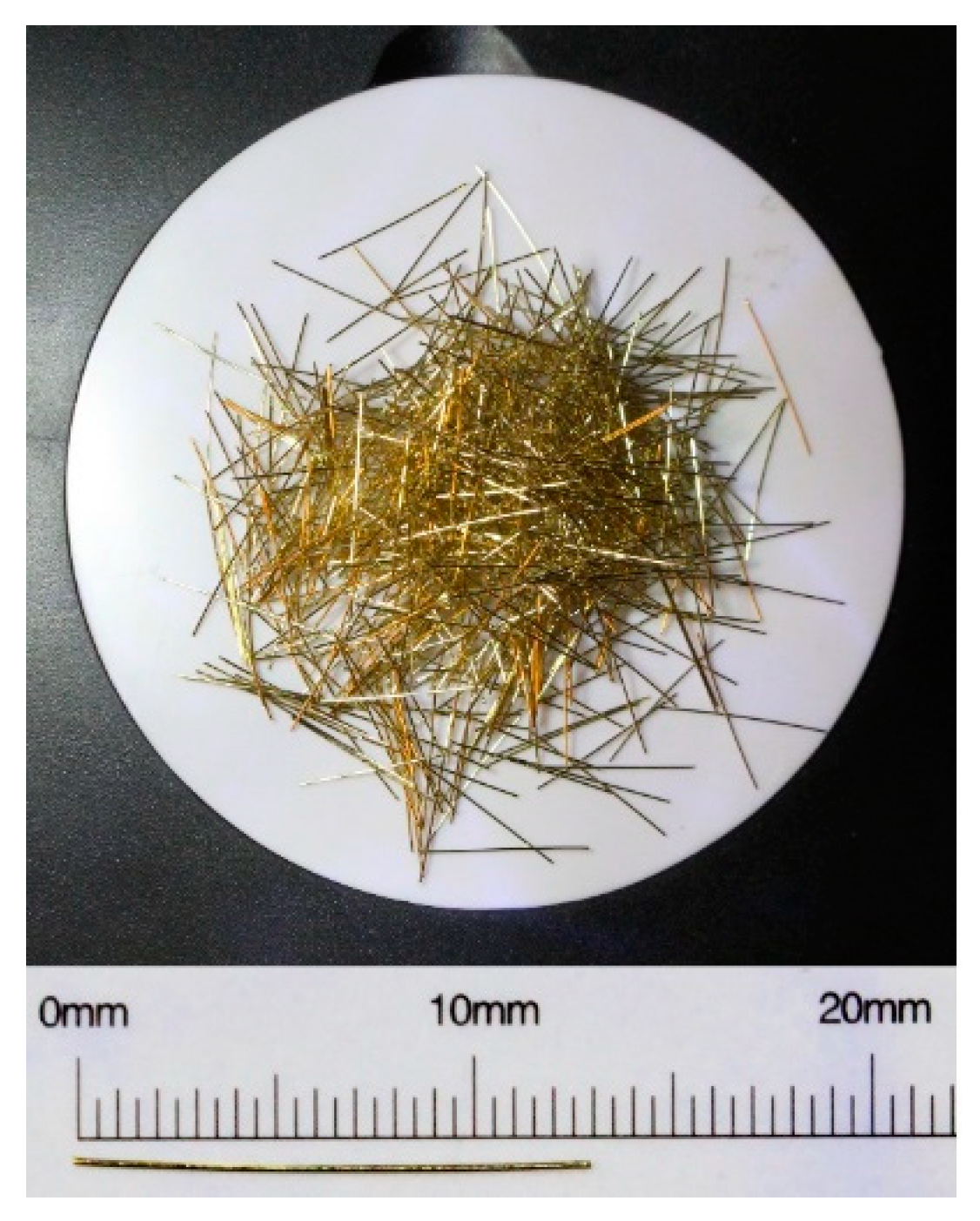

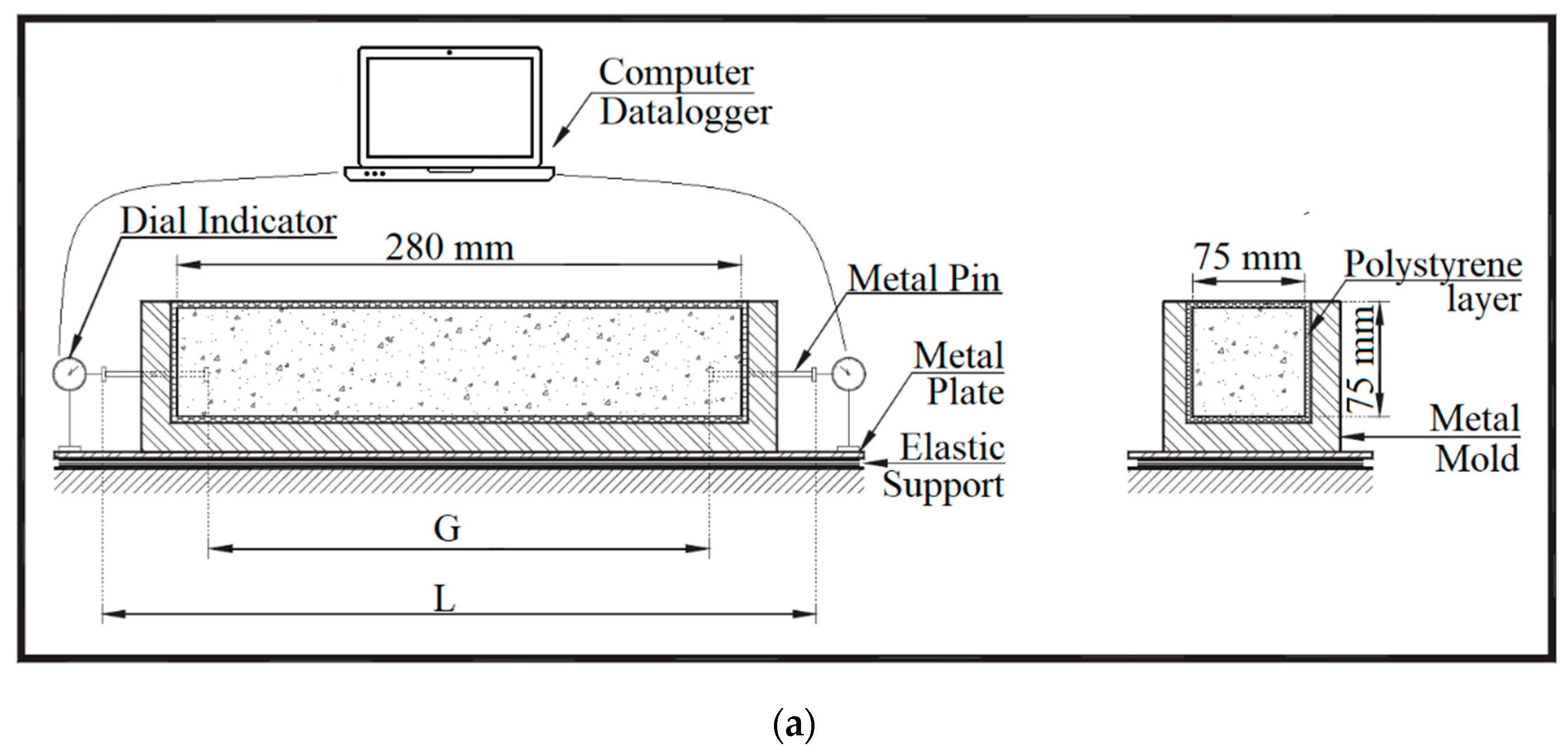
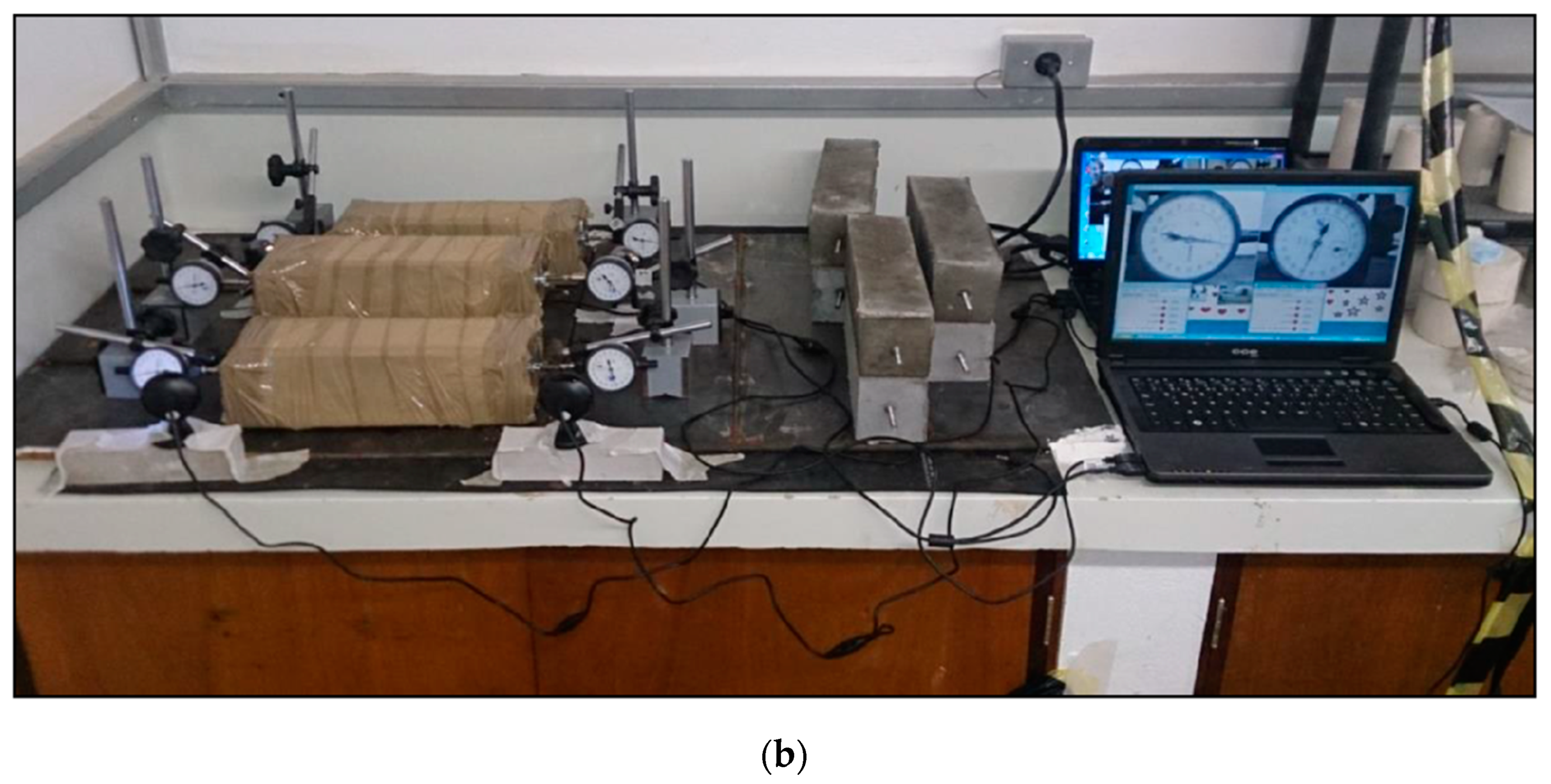
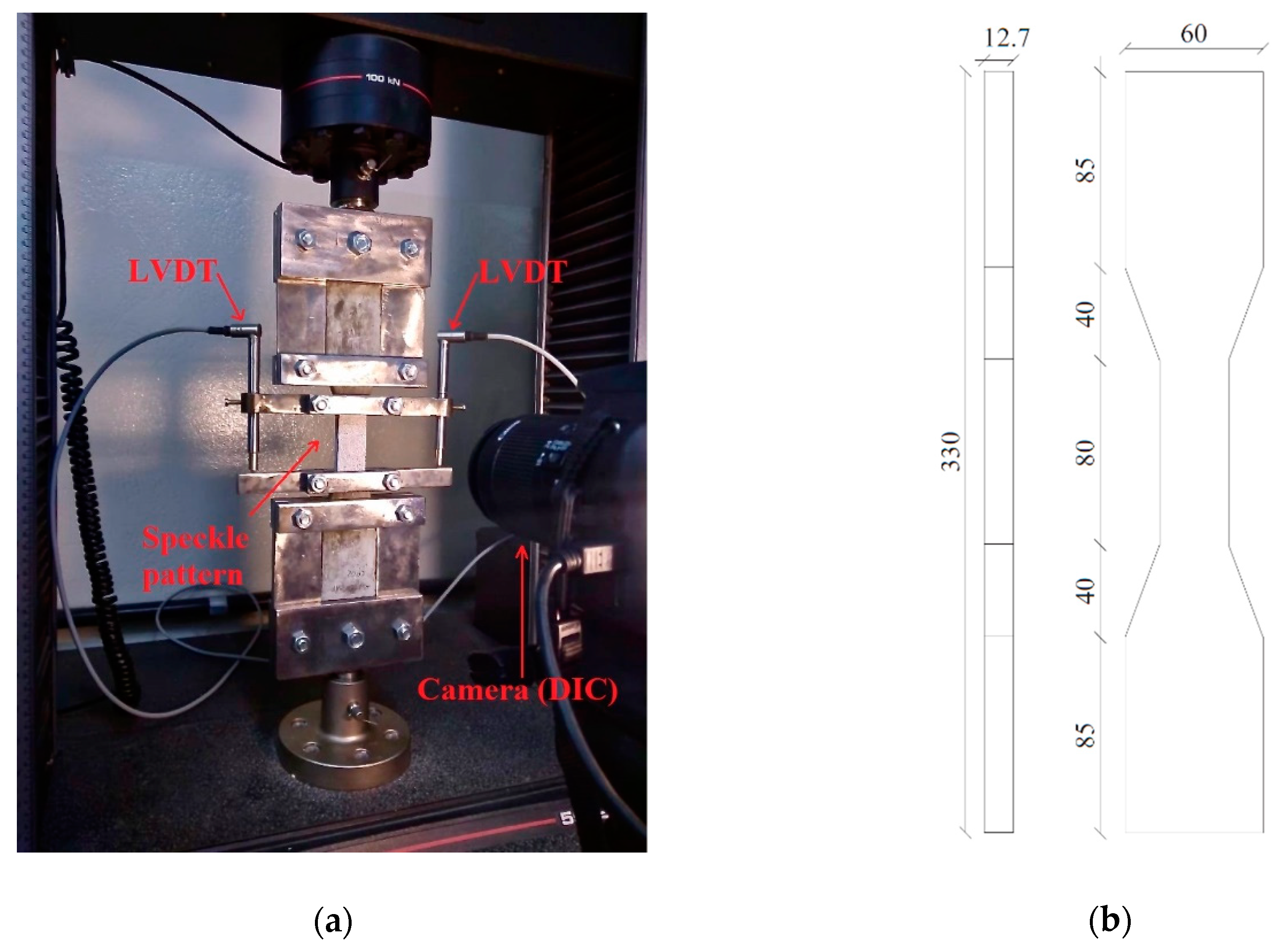
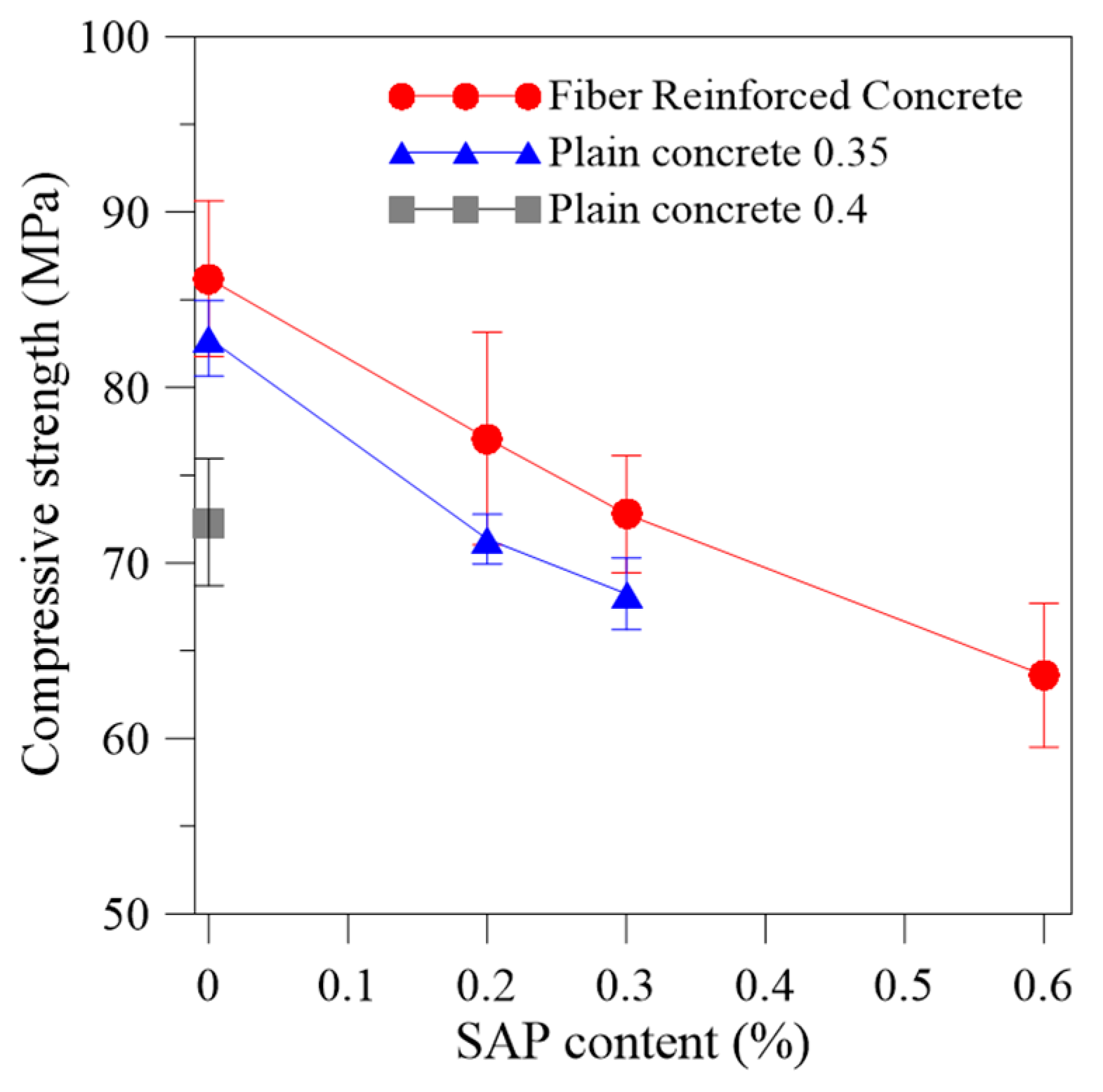

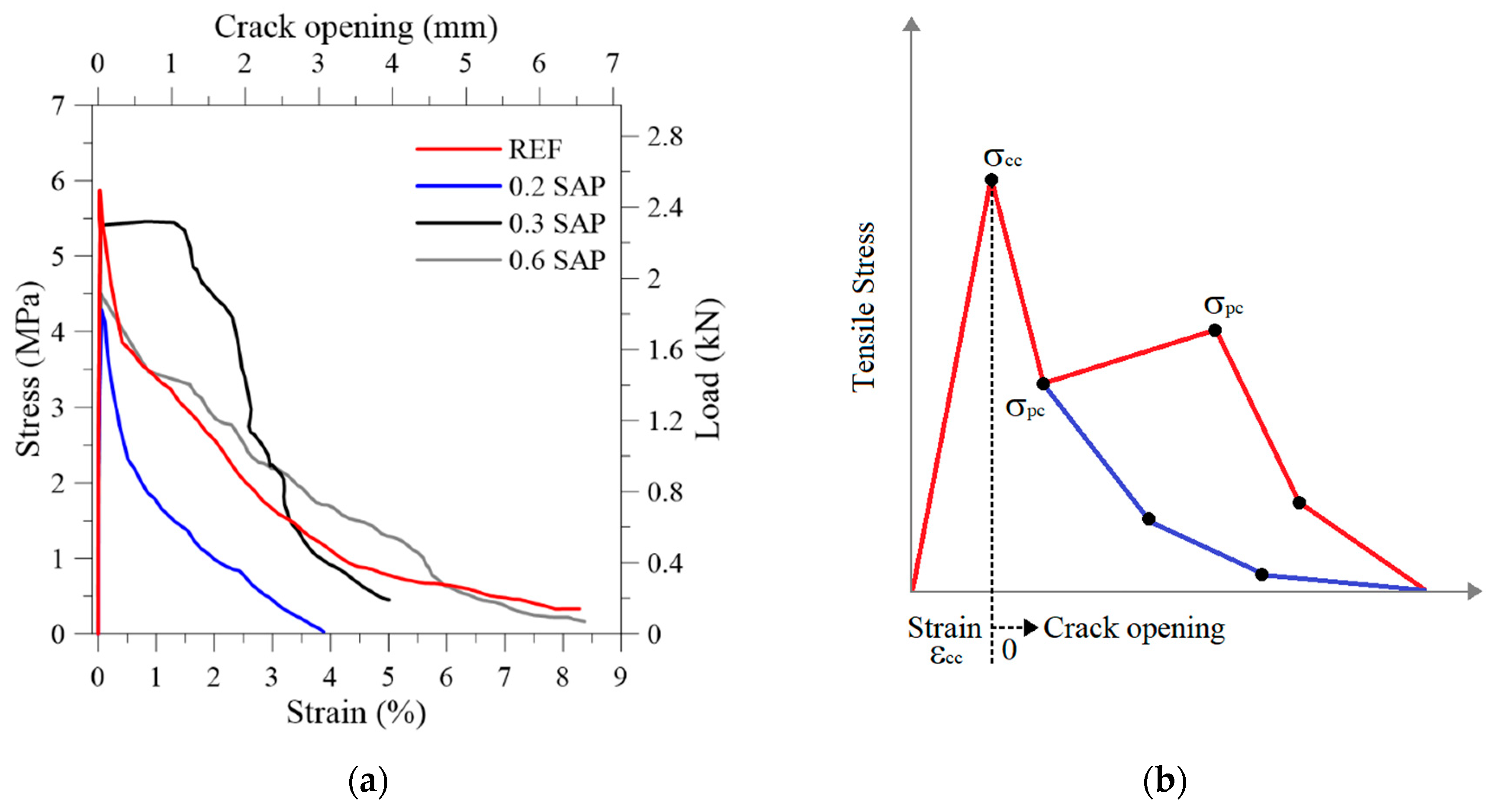
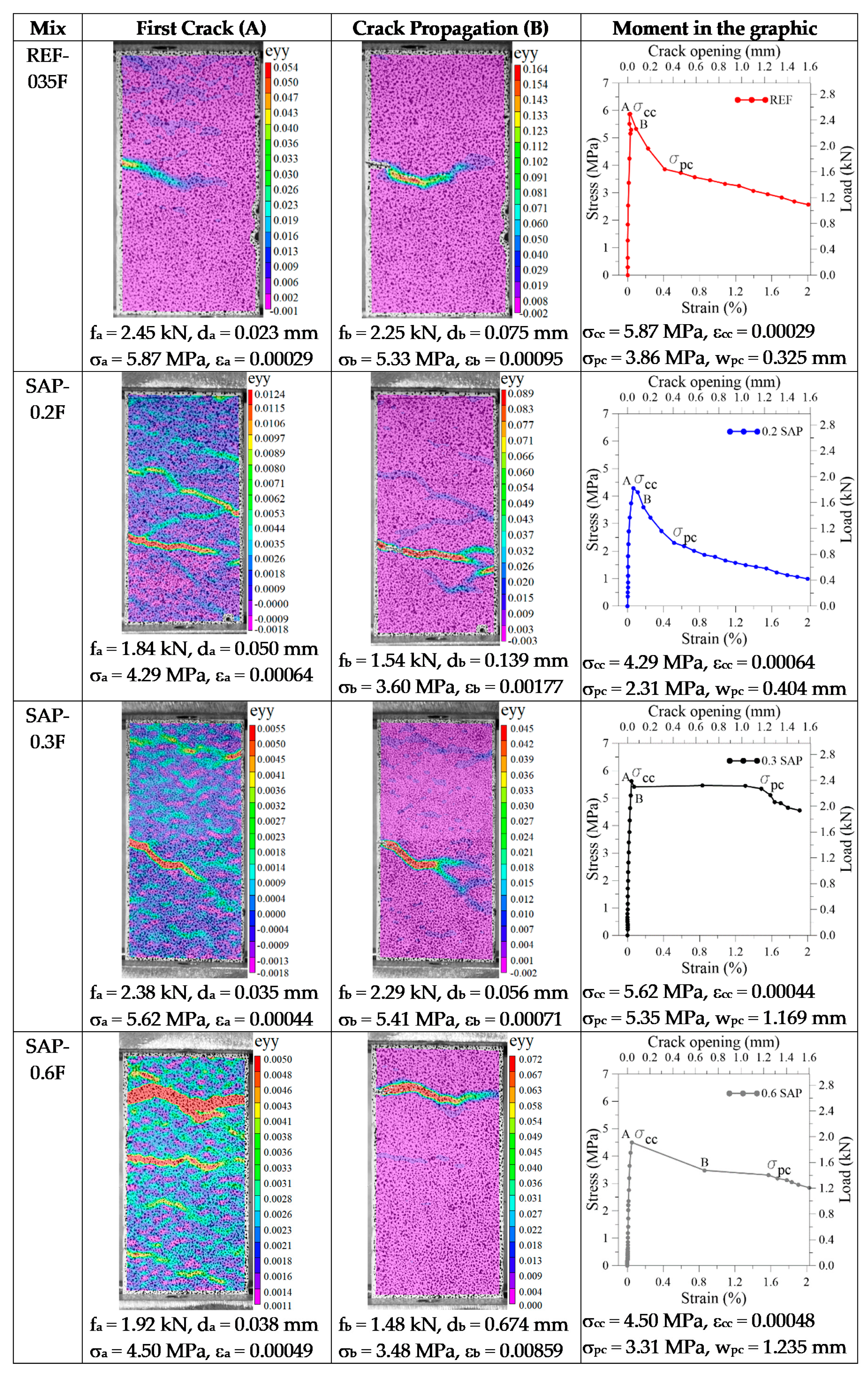
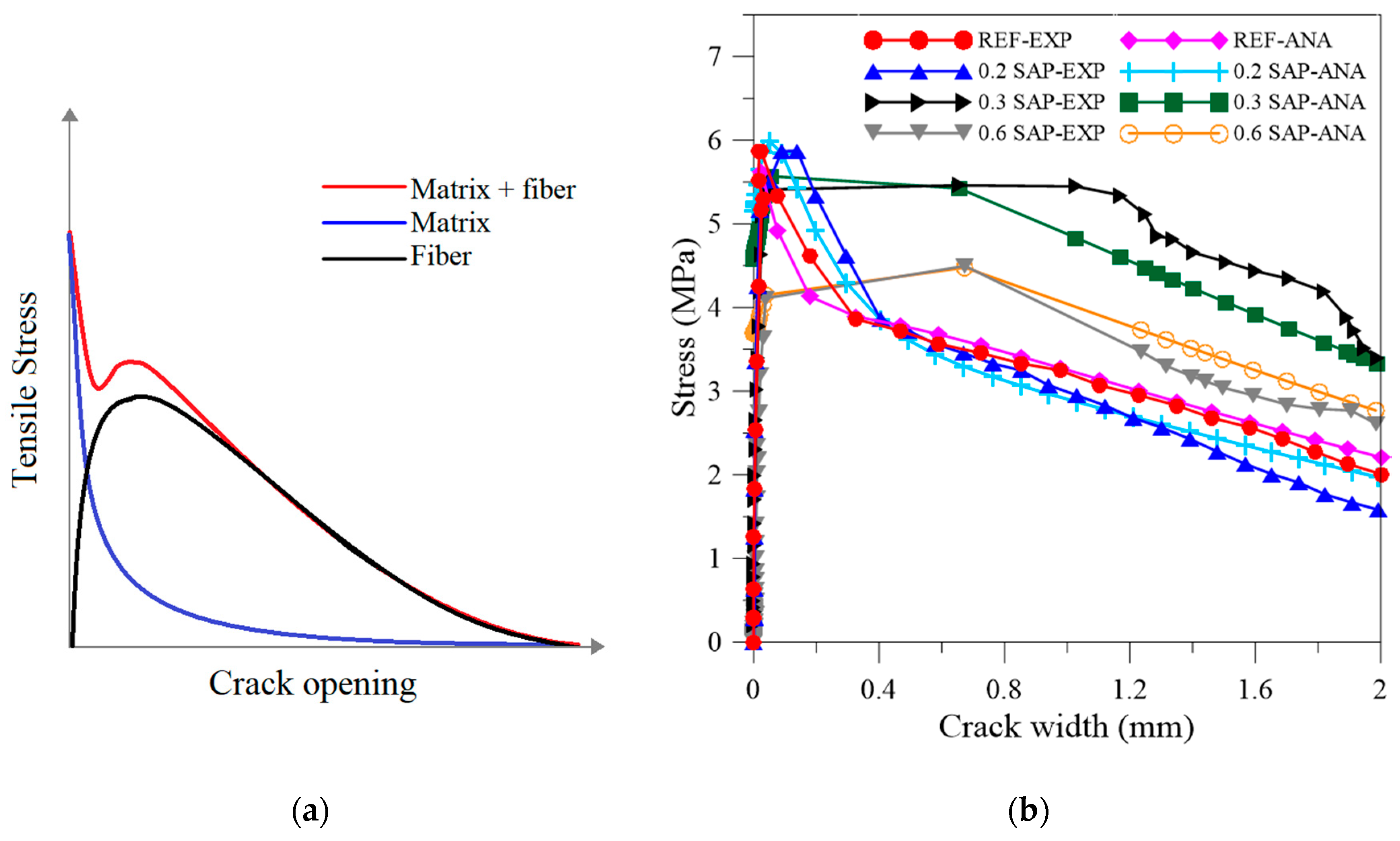
| Component | Cement (%) | Silica Fume (%) |
|---|---|---|
| SiO2 | 24.41 | 93.95 |
| Al2O3 | 7.09 | 0.16 |
| CaO | 53.74 | 0.74 |
| Fe2O3 | 3.02 | 0.27 |
| MgO | 4.36 | 0.86 |
| SO3 | 3.28 | - |
| Na2O | 0.28 | 0.37 |
| K2O | 0.77 | 0.84 |
| Density (g/cm3) | 3.03 | 2.21 |
| Mixture (kg/m3) | Cement | Silica | Sand | SAP | Fiber | Superplasticizer | w/c(basic) | w/c(total) 1 | Flow (mm) |
|---|---|---|---|---|---|---|---|---|---|
| REF-035 | 675.8 | 67.6 | 1306.5 | 0 | 0 | 11.15 | 0.35 | 0.35 | 183 |
| REF-040 | 654.2 | 65.4 | 1264.5 | 0 | 0 | 8.50 | 0.40 | 0.40 | 200 |
| SAP-0.2 | 675.8 | 67.6 | 1306.5 | 1.35 | 0 | 12.50 | 0.35 | 0.38 | 183 |
| SAP-0.3 | 675.8 | 67.6 | 1306.5 | 2.03 | 0 | 12.50 | 0.35 | 0.40 | 180 |
| REF-035F | 675.8 | 67.6 | 1306.5 | 0 | 100 | 13.50 | 0.35 | 0.35 | 307 |
| SAP-0.2F | 675.8 | 67.6 | 1306.5 | 1.35 | 100 | 13.50 | 0.35 | 0.38 | 243 |
| SAP-0.3F | 675.8 | 67.6 | 1306.5 | 2.03 | 100 | 13.50 | 0.35 | 0.40 | 230 |
| SAP-0.6F | 675.8 | 67.6 | 1306.5 | 4.06 | 100 | 13.50 | 0.35 | 0.46 | 208 |
| Mixture | Mean Compressive Strength (MPa) | Strength Reduction Considering the w/c(basic) (%) | Mean Tensile Stress (MPa–First Cracking | Ratio of Tensile to Compressive Strength |
|---|---|---|---|---|
| REF-035 | 82.80 ± 2.1 | - | 5.39 | 0.065 |
| REF-040 | 72.32 ± 3.6 | - | 4.92 | 0.068 |
| SAP-0.2 | 71.36 ± 1.4 | 13.82 | 5.04 | 0.071 |
| SAP-0.3 | 68.24 ± 2.0 | 17.58 | 5.07 | 0.074 |
| REF-035F | 86.20 ± 4.4 | - | 6.01 ± 0.45 | 0.070 |
| SAP-0.2F | 77.09 ± 4.8 | 10.57 | 4.59 ± 0.25 | 0.060 |
| SAP-0.3F | 72.78 ± 4.8 | 16.47 | 5.92 ± 0.04 | 0.081 |
| SAP-0.6F | 63.60 ± 4.1 | 26.22 | 3.23 ± 0.23 | 0.051 |
| Mixture | Fcc (kN) | Fpc (kN) | σcc (MPa) | σpc (MPa) | dcc (mm) | εcc (%) | wpc (mm) | TTI (MPa) |
|---|---|---|---|---|---|---|---|---|
| REF-035F | 2.45 | 1.63 | 5.87 | 3.86 | 0.023 | 0.029 | 0.325 | 0.1336 |
| SAP-0.2F | 1.85 | 0.99 | 4.29 | 2.31 | 0.050 | 0.064 | 0.404 | 0.0491 |
| SAP-0.3F | 2.38 | 2.26 | 5.62 | 5.35 | 0.035 | 0.044 | 1.169 | 0.1623 |
| SAP-0.6F | 1.92 | 1.41 | 4.50 | 3.31 | 0.038 | 0.048 | 1.235 | 0.1491 |
Publisher’s Note: MDPI stays neutral with regard to jurisdictional claims in published maps and institutional affiliations. |
© 2020 by the authors. Licensee MDPI, Basel, Switzerland. This article is an open access article distributed under the terms and conditions of the Creative Commons Attribution (CC BY) license (http://creativecommons.org/licenses/by/4.0/).
Share and Cite
Santos, K.F.d.; Ribeiro, A.C.B.S.; Silva, E.F.d.; Manzano, M.A.R.; Motta, L.A.d.C.; Toledo Filho, R.D. Effect of the Combination of Superabsorbent Polymers for Autogenous Shrinkage Control with Steel Fibers of High-Performance Concrete under Uniaxial Tension Using DIC. Materials 2020, 13, 4638. https://doi.org/10.3390/ma13204638
Santos KFd, Ribeiro ACBS, Silva EFd, Manzano MAR, Motta LAdC, Toledo Filho RD. Effect of the Combination of Superabsorbent Polymers for Autogenous Shrinkage Control with Steel Fibers of High-Performance Concrete under Uniaxial Tension Using DIC. Materials. 2020; 13(20):4638. https://doi.org/10.3390/ma13204638
Chicago/Turabian StyleSantos, Karyne Ferreira dos, António Carlos Bettencourt Simões Ribeiro, Eugênia Fonseca da Silva, Manuel Alejandro Rojas Manzano, Leila Aparecida de Castro Motta, and Romildo Dias Toledo Filho. 2020. "Effect of the Combination of Superabsorbent Polymers for Autogenous Shrinkage Control with Steel Fibers of High-Performance Concrete under Uniaxial Tension Using DIC" Materials 13, no. 20: 4638. https://doi.org/10.3390/ma13204638
APA StyleSantos, K. F. d., Ribeiro, A. C. B. S., Silva, E. F. d., Manzano, M. A. R., Motta, L. A. d. C., & Toledo Filho, R. D. (2020). Effect of the Combination of Superabsorbent Polymers for Autogenous Shrinkage Control with Steel Fibers of High-Performance Concrete under Uniaxial Tension Using DIC. Materials, 13(20), 4638. https://doi.org/10.3390/ma13204638





